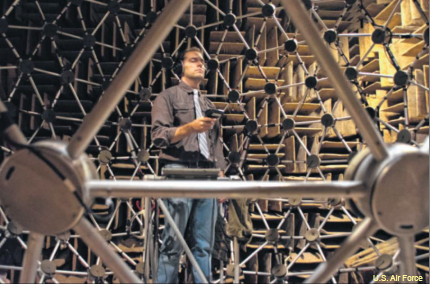AFRL's 3D audio helps pilots sort through the chatter
The lab's technology makes multiple audio feeds sound like their coming from different locations, adding clarity to each voice.

AFRL researcher Dr. Griffin Romigh tests 3-D audio software at Wright-Patterson Air Force Base, Ohio.
Pilots and air traffic controllers can sometimes run into a kind of big audio data problem—when multiple audio feeds, each with critical information, arrive at the same time and all run together, making difficult or impossible to distinguish an individual voice.
The Air Force Research Laboratory has developed a solution to the problem: 3D sound technology that separates those sounds the way the human ear differentiates voices speaking close by from those farther away. The research team at the lab’s Human Effectiveness directorate Battlespace Acoustics Branch hopes to soon incorporate the technology into Air Force and commercial operations, according to an Air Force release.
A key to what the Air Force calls multi-talker technology was separating multiple voices in a headset, which to the listener all seem to be coming from the same direction. Former AFRL researcher Dr. Douglas Brungart, one of the principal developers of the technology, had studied the way people discern sounds that are close from those far away while a student at the Massachusetts Institute of Technology and during his time at AFRL. Adding separate sound channels to a headset can make voices seem to be coming from different locations, which creates a 3D environment that makes the voices distinct and clear, the Air Force said.
"We've been excited about this technology for a long time, but previous applications have been limited by the relatively expensive hardware required to implement it," said Brungart, now the chief scientist at Walter Reed’s National Military Audiology and Speech Center. "However, as technology has advanced, the cost of implementing virtual audio has dropped dramatically."
The Air Force's Technology Transfer office has given aviation audio control systems developer PS Engineering an exclusive use license to incorporate the technology into its PMA450 audio system for general aviation.
"The all-new [digital audio system] brings to the pilot a new invention, thanks to the cooperative efforts of the U.S. Air Force," said Mark Scheuer, PS Engineering’s founder and CEO.
Dr. Brian Simpson, technical advisor to the Battlespace Acoustics Branch, said the technology, which is easy to learn and now low in cost, could have a significant impact. "The improvement is tremendous," Simpson said. "You can achieve greater communication effectiveness, reduce workload and, importantly, improve overall safety in flight operations. Even highly trained pilots, who are used to listening to multiple channels, can benefit from this technology, and the more complex the environment, the greater this benefit will be.
"I feel like we're on the tipping point," he said. "As soon as one flying community gets it, everyone else will want it."



